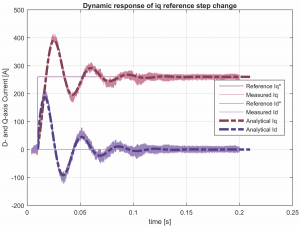Current-control dynamic response and stability analysis in high-speed permanent magnet synchronous machines based on complex state variables
Xiaolong Zhang with advisor K. Haran
To achieve benefits similar to those seen in hybrid-/all-electric ground-based and marine vehicles, electric propulsion has been proposed for large commercial aircraft. A high-power, high-speed permanent magnet synchronous machine (PMSM) is being developed to meet the stringent weight requirements in the aircraft application. Figure. 1 shows the architecture of a variable-frequency drive system comprising this PMSM. The dynamic response performance and stability of the inner-current control loop is of great importance to the reliable and efficient operation of the overall drive system. Modeling of this inner loop is accomplished with complex state variables. An analytical tool based on that modeling has been developed to predict the dynamic response and stability. This tool includes four different dq decoupling design options and practical effects caused by sampling delay. It reduces the computation time from around 30 minutes with a conventional method, i.e., Simulink physical modeling, to just a few seconds while maintaining similar accuracy, as shown in Fig. 2. Optimal tuning of the proportional-integral-differential current controller parameters is accomplished very efficiently. This research is supported by NASA.

